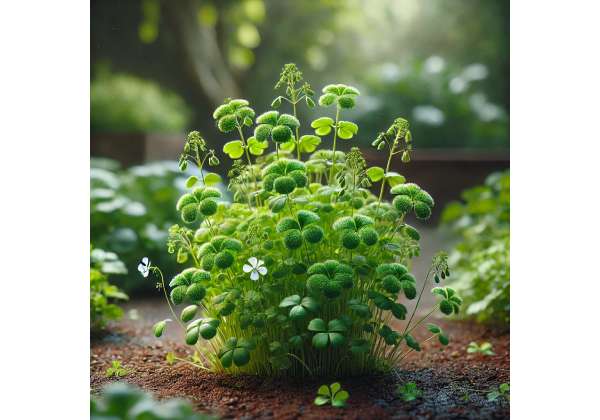Cress is a remarkable herb that packs a powerful nutritional punch in a small, peppery leaf. Revered for centuries in various cultures, cress (often referring to garden cress, watercress, or peppercress) is celebrated both as a culinary delight and a natural remedy. Its tangy, slightly spicy flavor not only enlivens salads and sandwiches but also provides a wealth of health benefits. Rich in vitamins, minerals, and antioxidants, cress has been used traditionally to support digestion, boost immunity, and promote cardiovascular health. Today, modern science is validating many of these traditional uses, making cress a favorite among natural health enthusiasts and culinary experts alike.
In addition to its gastronomic appeal, cress is admired for its rapid growth and ease of cultivation, making it accessible to home gardeners and urban farmers. Whether grown in a windowsill garden or as part of a larger organic farm, its nutrient-dense leaves add a burst of flavor and vitality to meals while offering a myriad of therapeutic benefits.
- High in vitamins A, C, and K, as well as essential minerals
- Rich in antioxidants and polyphenols for cell protection
- Supports digestion and boosts the immune system
- Promotes cardiovascular health and reduces inflammation
- Versatile in culinary dishes, salads, smoothies, and juices
- Easy to cultivate and harvest, making it popular among home gardeners
Table of Contents
- Cress: Botanical Characteristics and Identification
- Cress: Historical Context and Cultural Heritage
- Cress: Phytochemical Profile and Active Components
- Cress: Health Benefits and Holistic Contributions
- Cress: Natural Properties and Therapeutic Features
- Cress: Practical Uses, Applications, and Safety Guidelines
- Cress: Scientific Research and Study Insights
- Cress: Frequently Asked Questions (FAQ)
Cress: Botanical Characteristics and Identification
Cress belongs to the Brassicaceae family—a group that includes other nutrient-rich plants like broccoli, kale, and mustard greens. Whether you’re referring to garden cress, watercress, or peppercress, these plants share several key botanical traits that make them easily recognizable and highly valued for both their culinary and medicinal properties.
Physical Appearance and Growth
Cress plants are generally characterized by their delicate, small leaves and slender stems. Garden cress, for example, typically forms compact clusters of bright green, slightly serrated leaves. Watercress, on the other hand, is known for its lush, aquatic growth and vigorous, branching stems. Both types offer a crisp texture and a peppery, tangy flavor that can instantly elevate a dish.
Some defining botanical features include:
- Leaf Structure: Cress leaves are small, often oval to lanceolate, and possess a slightly wrinkled or crinkled texture. Their vibrant green color signals a high level of chlorophyll and nutritional content.
- Stem Characteristics: The stems are usually thin and delicate, with a subtle branching habit. In watercress, the stems may appear more robust and are often semi-aquatic.
- Growth Habit: Cress plants typically grow quickly, often maturing within just a few weeks from seed. This rapid growth makes them ideal for home gardeners who want a steady supply of fresh greens.
- Habitat: While garden cress prefers well-drained soil and can thrive in container gardens, watercress grows naturally in flowing streams and waterlogged soils. Both types, however, can be successfully cultivated in controlled environments with proper care.
Cultivation Tips
Cultivating cress is relatively straightforward, even for beginners. Here are a few practical tips for growing cress:
- Sowing and Germination: Cress seeds are extremely tiny, so it’s best to sprinkle them lightly over moist soil or hydroponic media. They require minimal soil cover and a steady supply of water.
- Light Requirements: Most cress varieties thrive in full sun to partial shade. In hotter climates, a little afternoon shade can prevent the leaves from scorching.
- Watering: While watercress naturally prefers moist conditions, garden cress needs consistent moisture but must be planted in well-draining soil to avoid root rot.
- Harvesting: Cress can be harvested as soon as the leaves are a few inches tall. Frequent harvesting encourages continuous growth and ensures you always have a fresh supply of nutrient-rich greens.
Identifying Cress in Nature
Even if you’re not cultivating cress, learning to identify it in the wild or at local markets can be a rewarding experience. Look for small, tender leaves with a peppery aroma and vibrant green color. Whether you encounter garden cress in a farmer’s market or spot watercress growing along a stream, these identifying features will help you recognize the herb’s potential benefits and culinary versatility.
Understanding the botanical characteristics of cress not only enhances your gardening skills but also deepens your appreciation for this humble yet powerful herb. Its rapid growth and nutrient density make it a standout in any natural setting.
Cress: Historical Context and Cultural Heritage
Cress has a storied past that reflects its significance in both ancient culinary traditions and traditional herbal medicine. Its use spans centuries and cultures, from ancient civilizations to modern kitchens, making it one of the most enduring and versatile herbs known to man.
Ancient Roots and Traditional Uses
Historical records indicate that cress was well-known in ancient Egypt, Greece, and Rome, where it was valued not only as a food source but also as a remedy for various ailments. Ancient texts mention its use to support digestion, boost vitality, and even enhance fertility. In traditional herbal medicine, cress was often used to prepare infusions and poultices believed to help with respiratory issues and digestive disturbances.
Some historical uses include:
- Digestive Aid: Ancient healers often recommended cress as a digestive stimulant. Its peppery flavor was thought to kick-start the appetite and support healthy digestion.
- Respiratory Relief: Cress was used in traditional remedies to help clear the respiratory tract, easing symptoms of coughs and colds.
- General Tonic: As a rich source of vitamins and minerals, cress was also considered a natural tonic that could rejuvenate the body and enhance overall health.
- Symbol of Vitality: In various cultures, cress symbolized renewal and growth, making it a popular motif in art and literature.
Cultural Significance Through the Ages
Cress has not only played a role in medicine but has also found its place in the culinary traditions of many cultures. In medieval Europe, for instance, cress was often added to soups and stews for its flavor and nutritional benefits. It became a staple in the diet of both peasants and nobility, celebrated for its ability to provide essential vitamins during the winter months.
In modern times, the resurgence of interest in superfoods and organic gardening has led to a renewed appreciation for cress. Its historical legacy as a “miracle herb” is being rediscovered by health enthusiasts who value natural, nutrient-dense foods. Culinary innovators now incorporate cress into smoothies, salads, and gourmet dishes, marrying ancient wisdom with contemporary culinary trends.
The Evolution of Cress in Modern Herbalism
Today, cress is recognized not only for its culinary applications but also for its potential health benefits. Modern herbalists have begun to systematically study its nutritional profile and bioactive compounds, validating many of the traditional claims. Whether it’s used fresh in a salad or processed into a concentrated extract, cress continues to serve as a bridge between ancient herbal traditions and modern health science.
The rich historical context of cress enriches our understanding of its role in both nutrition and traditional medicine. Its enduring popularity across cultures and centuries speaks to its intrinsic value as a natural, health-promoting herb.
Cress: Phytochemical Profile and Active Components
The impressive benefits of cress are largely attributable to its robust phytochemical profile. Packed with essential vitamins, antioxidants, and bioactive compounds, cress offers a nutritional bounty that supports overall health and vitality. In this section, we’ll break down the key active components that give cress its renowned health benefits.
Essential Vitamins and Minerals
Cress is a nutritional powerhouse that provides an abundance of vitamins and minerals essential for maintaining optimal health:
- Vitamin C: Cress is exceptionally high in vitamin C, an antioxidant that helps protect cells from damage and supports immune function.
- Vitamin K: This vitamin plays a critical role in blood clotting and bone health, and cress is a great natural source.
- Vitamin A: In the form of beta-carotene, vitamin A in cress supports eye health and immune function.
- Minerals: Cress is also rich in calcium, iron, and potassium, which are vital for bone strength, oxygen transport, and overall cellular function.
Powerful Antioxidants and Polyphenols
Antioxidants are one of the standout features of cress, helping to combat oxidative stress and reduce inflammation:
- Flavonoids: These potent antioxidants help neutralize free radicals, reducing the risk of chronic diseases and supporting heart health.
- Polyphenols: Compounds such as quercetin and kaempferol in cress contribute to its anti-inflammatory and anticancer properties.
- Carotenoids: In addition to vitamin A benefits, carotenoids also offer protective effects against environmental stressors.
Bioactive Compounds and Phytochemicals
The unique flavor and health benefits of cress are also linked to its diverse range of bioactive compounds:
- Glucosinolates: These sulfur-containing compounds are common in cruciferous vegetables and are known for their cancer-preventive properties.
- Isothiocyanates: Formed from glucosinolates, isothiocyanates play a role in detoxification and may help reduce inflammation.
- Essential Oils: Cress contains small amounts of essential oils that contribute to its peppery taste and antimicrobial properties.
Synergistic Interactions
The true power of cress lies in the synergy between its various nutrients and phytochemicals. The antioxidants work together with vitamins and minerals to create a robust defense against oxidative damage, while the glucosinolates and isothiocyanates support the body’s natural detoxification processes. This synergistic effect not only underpins the health benefits of cress but also makes it a valuable addition to a balanced diet.
Extraction and Standardization in Supplements
Modern dietary supplements often use standardized extracts of cress to ensure consistent levels of these active compounds. Whether in capsule form or as concentrated liquid extracts, these products are designed to provide the same nutritional benefits found in fresh cress, making it easier for individuals to integrate this powerful herb into their daily health routines.
Understanding the phytochemical profile of cress is key to appreciating its myriad health benefits. Its blend of vitamins, antioxidants, and bioactive compounds creates a natural synergy that supports overall health, helping to protect against oxidative stress and promote vitality.
Cress: Health Benefits and Holistic Contributions
Cress is not just a flavorful addition to meals—it’s also a nutritional powerhouse that offers a host of health benefits. From bolstering the immune system to supporting heart health and improving digestion, cress has a well-rounded profile that makes it a standout among leafy greens. Here, we dive into the holistic contributions of cress, detailing how its various components work together to promote overall well-being.
Immune System Support
Thanks to its high vitamin C content and rich antioxidant profile, cress is an excellent natural booster for the immune system. Vitamin C plays a crucial role in the production of white blood cells and in protecting the body from infections. Regular consumption of cress can help maintain a robust immune response, especially during the colder months when infections are more common.
Cardiovascular Health
Cress is known for its heart-friendly properties. The presence of antioxidants like flavonoids and polyphenols helps protect blood vessels from oxidative damage, reducing the risk of atherosclerosis and other cardiovascular conditions. Moreover, the potassium content in cress assists in maintaining healthy blood pressure levels, further supporting overall heart health.
Anti-Inflammatory and Anticancer Properties
The bioactive compounds in cress, including glucosinolates and isothiocyanates, have been linked to anti-inflammatory and anticancer effects. These compounds help the body neutralize free radicals and reduce chronic inflammation, which is a known risk factor for many types of cancer. By integrating cress into your diet, you may contribute to a lower risk of inflammation-related diseases.
Digestive Health and Detoxification
Cress is a natural source of dietary fiber, which is essential for a healthy digestive system. Fiber aids in regulating bowel movements, promoting a healthy gut microbiome, and supporting the body’s natural detoxification processes. Additionally, the isothiocyanates present in cress may enhance the activity of detoxification enzymes in the liver, aiding in the elimination of harmful toxins.
Skin and Eye Health
The antioxidants in cress, particularly vitamin A and carotenoids, are beneficial for maintaining healthy skin and good vision. These nutrients help protect the skin from environmental damage and support the regeneration of skin cells, while also contributing to overall eye health. Including cress in your diet can be a natural way to keep your skin radiant and your eyes sharp.
Holistic Well-Being
Cress’s benefits extend to promoting overall vitality. Its nutrient density and diverse array of bioactive compounds work synergistically to support energy levels, cognitive function, and a balanced metabolism. Whether enjoyed fresh in salads or as part of a nutrient-packed smoothie, cress provides a holistic boost that can enhance your overall quality of life.
The wide-ranging health benefits of cress make it an indispensable component of a balanced, nutrient-rich diet. By incorporating this small but mighty herb into your daily routine, you can harness its protective, restorative, and energizing properties to support long-term health.
Cress: Natural Properties and Therapeutic Features
Cress stands out for its impressive array of natural properties, which contribute to its effectiveness as both a food and a natural remedy. Its therapeutic features are driven by its rich content of antioxidants, vitamins, and bioactive phytochemicals, making it a versatile ingredient in both culinary and medicinal contexts.
Antioxidant Power
The antioxidant capacity of cress is one of its most significant therapeutic features. The high levels of vitamin C, flavonoids, and polyphenols help protect cells from oxidative stress by neutralizing free radicals. This not only supports immune function but also plays a role in reducing the risk of chronic diseases such as heart disease and cancer.
Anti-Inflammatory Effects
Cress’s bioactive compounds, particularly glucosinolates and isothiocyanates, offer strong anti-inflammatory benefits. These compounds help modulate the body’s inflammatory responses, which can alleviate symptoms of chronic inflammation and reduce the risk of inflammatory conditions. Whether applied as part of a dietary regimen or used in concentrated extracts, the anti-inflammatory effects of cress are a key component of its therapeutic value.
Detoxification and Digestive Support
Fiber and specific phytochemicals in cress support the body’s natural detoxification processes. Dietary fiber promotes healthy digestion and regular bowel movements, while isothiocyanates stimulate the activity of liver detoxification enzymes. Together, these properties help clear toxins from the body and maintain a healthy digestive system.
Skin and Cellular Health
The vitamins and antioxidants present in cress, especially vitamin A and carotenoids, contribute to skin health and cellular regeneration. These nutrients help maintain skin elasticity, protect against ultraviolet damage, and promote the repair of damaged tissues. As a result, cress is sometimes used in natural skincare formulations and home remedies aimed at enhancing skin vitality.
Synergistic Therapeutic Actions
The therapeutic power of cress is largely due to the synergistic interactions among its various components. The combination of antioxidants, anti-inflammatory agents, and detoxifying fibers creates a comprehensive support system for the body’s natural healing processes. This synergy makes cress an excellent natural remedy for promoting overall health and resilience.
In summary, the natural properties and therapeutic features of cress provide a robust foundation for its health-promoting benefits. Its multifaceted profile supports a range of bodily functions—from cellular protection and skin health to digestion and detoxification—making it a versatile and valuable herb in any natural wellness regimen.
Cress: Practical Uses, Applications, and Safety Guidelines
Cress is a highly versatile herb that can be enjoyed in a variety of ways, both as a culinary ingredient and as a natural health booster. Its peppery flavor and impressive nutritional profile make it a popular choice in salads, sandwiches, and smoothies, while its therapeutic properties are harnessed in juices and herbal supplements. Here’s a closer look at how you can integrate cress into your everyday life safely and effectively.
Culinary Applications
Cress adds a delightful burst of flavor to many dishes. Its peppery, slightly spicy taste can elevate even the simplest recipes. Here are some popular culinary uses:
- Salads: Fresh cress leaves can be tossed into salads for a tangy kick and extra crunch.
- Sandwiches and Wraps: Add a handful of cress to your favorite sandwiches and wraps to enhance flavor and nutritional content.
- Smoothies and Juices: Blend cress into green smoothies or fresh juices to boost vitamin and antioxidant levels.
- Garnishes: Use cress as a garnish to add color and flavor to soups, stews, and other dishes.
- Herbal Sauces: Incorporate cress into pesto or other herb-based sauces for a unique twist on traditional recipes.
Medicinal and Nutritional Uses
Beyond its culinary appeal, cress is highly regarded for its health-promoting properties:
- Dietary Supplement: Cress can be consumed fresh or in powdered form to provide a nutrient boost. Its high levels of vitamins and antioxidants support immune function and overall health.
- Juice and Smoothie Additive: Incorporating cress into juices or smoothies not only enhances flavor but also delivers a potent dose of nutrients, making it an excellent choice for a morning health kick.
- Herbal Infusions: Cress tea, made by steeping fresh or dried leaves in hot water, can aid digestion and provide a refreshing, nutrient-rich beverage.
- Topical Applications: In some traditional practices, cress extracts are used in skincare formulations to harness its antioxidant properties for skin repair and rejuvenation.
Safety Guidelines and Best Practices
While cress is generally safe to consume and use, it’s important to follow a few safety guidelines:
- Moderation: As with any nutrient-dense herb, consume cress in moderation to avoid potential issues such as an upset stomach.
- Source Quality: Use fresh, organic cress whenever possible. Ensure that it is sourced from reputable suppliers to avoid contamination or pesticide residues.
- Allergy Check: Although rare, some individuals may be sensitive to cress. If you experience any adverse reactions, discontinue use and consult a healthcare provider.
- Storage: Store cress properly in the refrigerator and use it within a few days to preserve its nutritional quality and flavor.
- Preparation: When incorporating cress into recipes, wash it thoroughly to remove any dirt or impurities, especially if you are foraging for it in the wild.
Integrating Cress into Daily Life
Cress is incredibly easy to incorporate into your daily routine. Whether sprinkled on your morning salad, blended into a revitalizing smoothie, or enjoyed as a fresh herb in sandwiches, its versatility makes it a valuable addition to your diet. For those seeking natural health benefits, a daily serving of cress can help boost immunity, support digestion, and provide a rich array of vitamins and antioxidants.
By following these practical guidelines and enjoying cress in a variety of ways, you can safely harness its benefits and add a zesty, nutritious element to your meals.
Cress: Scientific Research and Study Insights
Modern scientific research has increasingly focused on cress, confirming many of the traditional health claims and revealing new insights into its benefits. Studies have examined its rich phytochemical content, antioxidant capacity, and potential roles in preventing chronic diseases, thereby validating its reputation as a superfood.
Key Research Findings
Several noteworthy studies have highlighted the health-promoting properties of cress:
- Antioxidant Capacity: A 2017 study published in the Journal of Agricultural and Food Chemistry demonstrated that cress extracts exhibit high antioxidant activity, largely due to their rich content of vitamin C, flavonoids, and polyphenols. These antioxidants play a vital role in protecting cells from oxidative stress.
- Cardiovascular Benefits: Research in the European Journal of Nutrition (2018) found that regular consumption of cress can help improve endothelial function and reduce blood pressure. The high levels of potassium and antioxidants in cress support heart health by promoting better circulation and reducing inflammation.
- Anticancer Potential: Preliminary studies have indicated that the glucosinolates present in cress may have anticancer properties. A 2016 investigation in Food Chemistry highlighted how these compounds can modulate detoxification enzymes and potentially reduce the risk of certain cancers.
- Digestive Health: Clinical research has also noted that the dietary fiber and bioactive compounds in cress contribute to improved digestion and a healthier gut microbiome. A study in the International Journal of Food Sciences and Nutrition (2019) underscored the role of cress in promoting regular bowel movements and enhancing nutrient absorption.
Research Methodologies and Implications
Researchers have used a variety of methodologies—from in vitro assays to human clinical trials—to assess the benefits of cress. These studies typically focus on:
- Extraction Techniques: Modern extraction methods ensure that the bioactive compounds in cress are concentrated and standardized for research and therapeutic use.
- Dose-Response Relationships: Understanding how different concentrations of cress extracts affect various physiological processes helps in developing effective dietary supplements.
- Comparative Studies: By comparing the antioxidant and anti-inflammatory properties of cress with other leafy greens, researchers have confirmed its superior nutritional profile.
Cress: Frequently Asked Questions (FAQ)
How does cress benefit overall health?
Cress is packed with vitamins, antioxidants, and bioactive compounds that support immune function, cardiovascular health, and digestion. Its high levels of vitamin C and flavonoids help protect against oxidative stress and inflammation, making it a nutritious addition to your diet.
Can I eat cress raw, or should it be cooked?
Cress can be eaten raw in salads or sandwiches to preserve its high nutrient content. It can also be lightly cooked or blended into smoothies, but excessive heat may reduce some of its vitamin levels.
Are there any side effects associated with consuming cress?
Cress is generally safe when consumed in moderation. However, individuals with thyroid issues or sensitivities to cruciferous vegetables should consult with a healthcare provider, as large quantities may affect thyroid function.
Disclaimer
The information provided in this article is for educational purposes only and should not be taken as a substitute for professional medical advice. Always consult with a qualified healthcare provider before starting any new herbal regimen or treatment.
If you found this article useful, please consider sharing it on Facebook, X (formerly Twitter), or your preferred social media platform. Your support helps spread natural wellness solutions like cress to a wider audience!

















